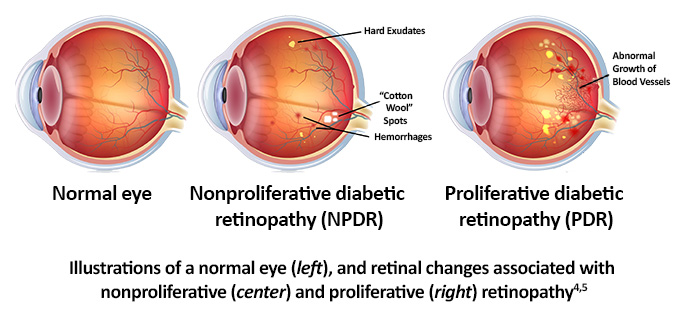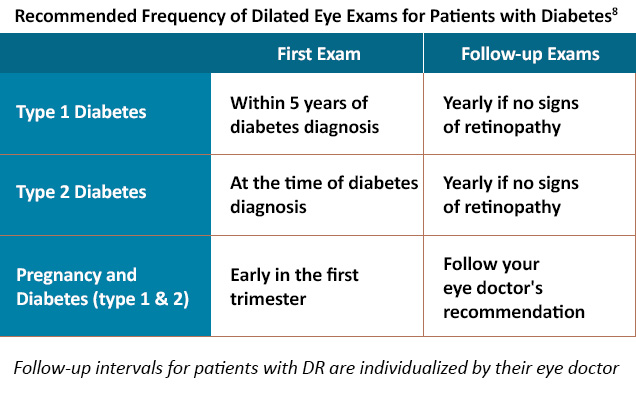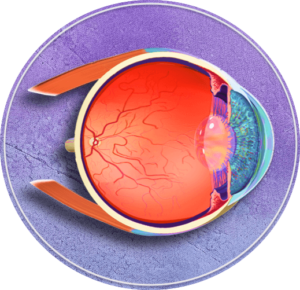Screening and Diagnosing DR
Diabetic retinopathy (DR) is an eye disease caused by hyperglycemia-induced damage to blood vessels in the retina.1 DR is the microvascular manifestation of end-organ damage in diabetes, with affected blood vessels swelling and leaking fluid and blood into the retina.1,2 Vessel blockage may also occur, resulting in retinal ischemia and upregulation of vascular endothelial growth factor (VEGF), and may lead to the growth of abnormal, fragile, new retinal blood vessels.1,2 These new vessels also leak and hemorrhage, eventually forming scar tissue that can lead to retinal tears and detachment, as well as permanent vision loss.1,2
DR is classified into two main types, nonproliferative and proliferative retinopathy, with the abnormal growth of vessels as a characteristic feature of advanced, proliferative disease.2 Swelling into the macula (the area of retina responsible for central vision) is termed diabetic macular edema (DME) and can occur at any stage of retinopathy, although it occurs more frequently with increasing severity of DR.2,3

DR can be present without symptoms, even when the disease is severe; therefore, early detection and timely treatment of DR are imperative in delaying and potentially preventing vision impairment and blindness.1,6-8 In fact, early detection may lower the risk of vision loss by more than 90%.5,8-9 However, more than half of those with diabetes do not receive eye examinations or are diagnosed too late for treatment to have a beneficial impact on vision.7
Primary care providers play a central role in the screening and management of patients with diabetes and of those already diagnosed with DR. Referral for dilated eye examinations are recommended for all patients with diabetes, with timing of the initial screening exam dependent on diabetes type and/or pregnancy status.8 After the initial exam, intervals for follow-up exams are individualized by the eye care team based on the presence and severity of retinopathy.8 Dilated eye exams may also be accompanied by imaging with optical coherence tomography (OCT) to look at the layers of the retina, and can be used to monitor response to treatment.1,9

Furthermore, educating patients about the importance of eye exams (even in the absence of symptoms), the progressive nature of retinopathy, and the impact of early treatment can positively effect eye health.7,8,10 Through such education and timely referral, primary care is highlighted as a vital component in facilitating diagnosis, encouraging examination as well as treatment adherence and, ultimately, improving visual outcomes that can maximize vision-related quality of life for patients with diabetes.7,8,10
References
- Boyd K; American Academy of Ophthalmology. Diabetic Retinopathy: Causes, Symptoms, Treatment. October 27, 2022. https://www.aao.org/eye-health/diseases/what-is-diabetic-retinopathy
- Kim JE, Feldman BH, Hsu, Jason, et al. American Academy of Ophthalmology. Diabetic retinopathy. EyeWiki® . Last reviewed
June 21, 2025. https://eyewiki.org/Diabetic_Retinopathy - Jacoba CMP, Mitzner MG, Bhagat N, et al. American Academy of Ophthalmology. Diabetic retinopathy. EyeWiki® . Last reviewed
July 6, 2025. https://eyewiki.org/Diabetic_Macular_Edema - EyeCare Associates of South Tulsa. Diabetic retinopathy? https://www.southtulsaeye.com/treatments-diabetic-retinopathy/
- Exeter Eye. Diabetic retinopathy. https://www.exetereye.co.uk/eye-conditions/diabetic-retinopathy/
- Diabetic Retinopathy. National Institutes of Health. National Eye Institute. Last updated September 11, 2025. https://www.nei.nih.gov/learn-about-eye-health/eye-conditions-and-diseases/diabetic-retinopathy
- Centers for Disease Control (CDC). Vision and Eye Health. About common eye disorders and diseases (diabetic retinopathy). May 15, 2024. https://www.cdc.gov/vision-health/about-eye-disorders/index.html
- Lim JI, Kim SJ, Bailey ST, et al. Diabetic Retinopathy Preferred Practice Pattern®. Ophthalmology. 2025;132:P75-P162.
- Wong TY, Sun J, Kawasaki R, et al. diabetic eye care: the International Council of Ophthalmology recommendations for screening, follow-up, referral, and treatment based on resource settings. Ophthalmology. 2018;125;1608-1622.
- Silva, PS. Diabetic retinopathy: screening. In: Nathan DM, Trobe J, Rubinow K, eds. UpToDate. Last updated June 16, 2025. https://www.uptodate.com/contents/diabetic-retinopathy-screening
URLs accessed December 18, 2025.






